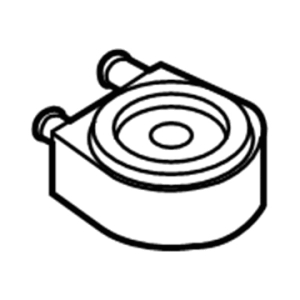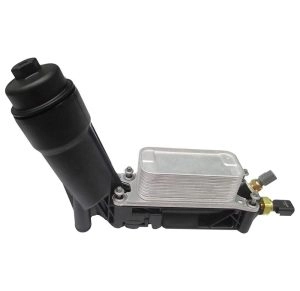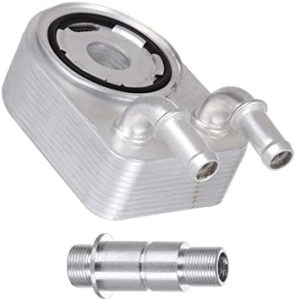The engine oil cooler is one of the most important components in the car engine. It works to cool the engine oil, prolong its life, and prevent heat and friction in the engine.
When the engine oil cooler is damaged, it means that the engine oil is no longer being adequately cooled, which leads to faster engine wear and tear. Therefore, in this article, we will discuss what an engine oil cooler is, the types of oil coolers, signs of its damage, and how to determine when it needs to be replaced.

What is the engine oil cooler?
The radiator is a heat exchanger that is used to cool the engine oil. It works by lowering its temperature and prolonging its lifespan. There are different types of car engine oil coolers, which vary in performance and operation method.
Types of Engine Oil Coolers
Air Coolers
It worksAir CoolersThe cooling of the engine oil is achieved through the air passing over it. These coolers consist of pipes made from heat-conductive metals, through which the engine oil passes. These coolers are installed in the front part of the engine.
It is operated by the fans located at the front of the radiators, where the air that propels them is passed through the radiators to cool the oil.
Among the disadvantages of the air cooler is its ineffectiveness in cooling, especially in high temperatures. It also requires regular maintenance of the fans and cleaning the cooler from dirt and sediments.
Liquid Coolants
It depends on the passage.Engine OilInside it, the heat is converted into coolant, which is circulated in the engine's cooling circuit. These radiators are made up of a series of pipes made from heat-conductive metals.
It is installed on the front part of the engine, and the coolant is circulated via a special pump that works to transfer the heat from the radiators to the coolant.
One of the most significant advantages of liquid coolants is their ability to control the engine temperature more effectively and efficiently. They function better at high temperatures and require less maintenance compared to air coolers.
One of the noted flaws of the liquid radiator is the complexity of its installation and the potential for leakage.
Water Coolers
These radiators use radiator water to cool the engine oil, where the water is circulated around the radiator to cool it.
Oil Coolers
This type of radiator is used to circulate and cool oil, and is considered the most effective in cooling. Oil radiators consist of pipes and motors that help convert high oil pressure into low pressure, thus cooling it.
Also read: Engine Oil: The top 3 reasons that turn the oil black?
Signs of Engine Oil Cooler Damage
1- Engine temperature increase:
When the oil cooler is damaged, it affects the oil flow and its cooling, leading to an abnormal rise in the engine temperature.
2- Oil Leakage:
Damage to the car engine's oil cooler can lead to oil leakage from the engine, especially in locations near the cooler.
3- Unusual Sound:
When the engine oil cooler is damaged, it can lead to an unusual sound from the engine, which is an indicator of a problem with the cooler.

Reasons for Engine Oil Cooler Failure
1- Low engine oil level.
If the engine oil level is low, it may cause improper heat distribution within the engine, leading to an increase in its temperature and a malfunction in the oil cooler.
2- Damage to the sensors
Damage to the engine temperature sensors or oil pressure may cause the fan responsible for cooling the engine oil to not operate.
3- Blockage of passages
The passages inside the radiator can get blocked due to the buildup of deposits and dirt over time, which prevents the flow of oil and causes a malfunction in the radiator.
4- Oil pump failure
If the oil pump is damaged, it may not be able to circulate the oil properly, leading to insufficient cooling of the engine oil.
5- Oil Leakage
If there is a leak in the oil system, it may lead to a reduction in the amount of oil flowing through the radiator, which affects its performance and can lead to a breakdown.
6- Increase in engine temperature
If the engine temperature rises excessively, this may cause the radiator to be unable to handle the amount of heat produced, leading to a radiator malfunction.
7- Accumulation of dirt in the oil.
Dust, dirt, and impurities may accumulate in the oil over time, leading to damage to the radiator and its inability to adequately cool the oil.
8- Damage to the radiator fans
If the radiator fans suffer any kind of damage, they may not be able to move air properly, which affects their ability to cool the oil.
9- Using unsuitable oils
If unsuitable oils are used, or if they are chosen incorrectly, this can lead to damage and breakdown of the radiator.
10- Neglecting regular maintenance
Regular maintenance should be performed on the radiator and oil system. If this is ignored, it could lead to damage to the radiator and its inability to adequately cool the oil.
How to determine when the engine oil cooler needs to be replaced?
Drivers should pay attention to how long the engine oil cooler has been in use, and it's possible to determine when the engine oil cooler needs to be replaced by checking the color and quality of the engine oil.
If the color is abnormal or contains impurities or deposits, it's time to replace the radiator. You can also rely on the mileage covered or the time specified in the car owner's manual.

Conclusion
The engine oil cooler is considered one of the most important components in the car engine, and it should be taken care of as a basic part of car maintenance. It significantly contributes to improving engine performance and reducing additional costs associated with engine repair and replacement. It works to cool the engine oil and extend its life.
Drivers should pay attention to possible signs of needing to change the car engine oil, such as a loud and abnormal engine noise, increased fuel consumption, increased engine temperature, and the smell of burning oil.

Comments